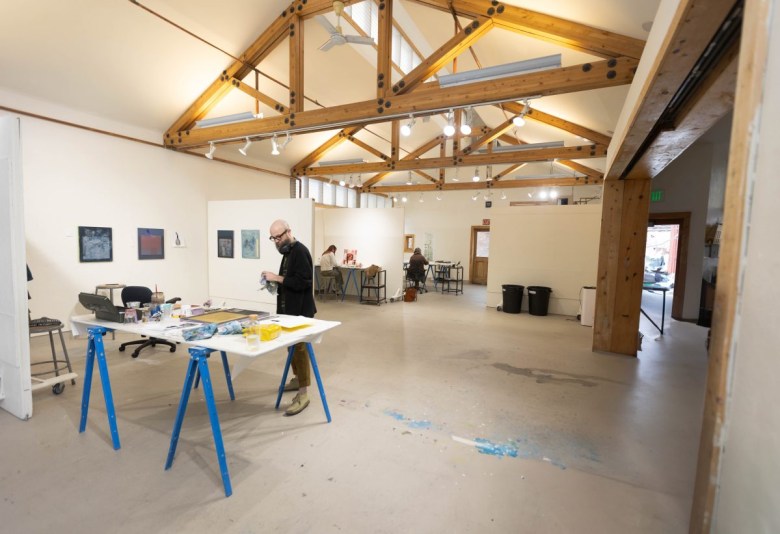Residencies are often a staple in artists’ lives, important in building a career. Though a small number of well-known programs allow or even encourage families, such as Headlands Center for the Arts in Sausalito, Roswell Artist-In-Residence Program, and Collar Works Elizabeth Murray Artist Residency in Troy, few with national or international reputations do so.
But there is good news on the horizon. In 2020, Elizabeth Ferrill, chair of the Artists-in-Residence program at Anderson Ranch Arts Center in Snowmass Village, Colorado, told Hyperallergic that they were “exploring the possibility of a family program.”
Three years later, Ferrill engineered a pilot residency for three families that debuted last November and December. Artist Rubens Ghenov arrived with his partner Lynne, as well as their son and daughter, ages 18 and 16, respectively. Trey Hill came with his partner and four-year-old son, and Rebecca Drolen with her partner and eight-year-old daughter.

Anderson Ranch pulled out all the stops for its pilot families. “I have a four- and a six-year-old,” Ferill told Hyperallergic in a recent interview. “When I became a parent, I suddenly saw my opportunities for residency programs diminish [at the same time that] I was getting all these inquiries from fellow artist-parents wanting to come to the ranch. I wanted to use this pilot to experiment.”
Such experiments are crucial for artist-parents. Rubens Ghenov, a veteran of five residencies, told Hyperallergic that he believes that “anything that impedes an artist from doing what they need, want, believe, and care to do should be excised from the equation within places that exist to foster artists.” While Ghenov is not suggesting that artists should be given a behavioral free pass, he argues that institutions devoted to artists must find a way to embrace those whose participation depends upon childcare.
A statement on the application guidelines section of the website for MacDowell, a preeminent artists’ residency in New Hampshire, is typical of most programs: “MacDowell is not equipped to accommodate partners, children or other family members as guests at this time.” While the site affirms that MacDowell does not discriminate against classes protected by civil rights law (race, gender, etc.), such equity and inclusion do not yet legally extend to parents. MacDowell is hardly alone. The Frequently Asked Questions on Yaddo’s website include the following: “Does Yaddo accommodate family or pets? No. Yaddo prioritizes good working conditions for artists.” It is an all-too-common belief that children are irreconcilable with art.
Courtney Bethel, Admissions Director at MacDowell, explained to Hyperallergic via Zoom this January that while a few artists have been permitted to bring infants, this privilege is granted on a case-by-case basis, and is rare. However, access for artist-parents is an ongoing conversation between MacDowell’s management and its board.
At Anderson Ranch, Ferrill’s team has the advantage of a year-round children’s program, so they organized classes, providing the children a taste of facilities such as the ceramics studio, digital fabrication lab, and print shop and letting them explore a variety of media. “We had the whole staff focused on these three families, which was an extreme luxury for us and them,” she recalled.
Devoting a residency’s full resources to three families is not sustainable, but the Ranch’s future plan promises an excellent and affordable model. Starting in 2025, artists can bring children if a caretaker also attends. Though arranging care is still not easy for a family, it is far better than a closed door. Ranch staff will supply a list of local community resources oriented toward children, including skating rinks, camps, and the like. Families will eat with other residents, enabling crucial bonding, networking, and professional opportunities. Including artist-parents benefits everyone; as Rubens Ghenov put it, “It’s important for artists who don’t have families to see those that do — that they are able to make, think, and shape culture and the world with partners and kids.”
Anderson Ranch’s 2025 vision might sound minimal, but it is enough. Artist-parents simply need a chance to participate without radically upsetting family life. Hill, who has completed eight residencies, said that “good opportunities for my career often create a burden for my partner.” At Anderson, however, his son came to the studio with him to make his own work. (His son is five, though, so the “work” consisted of ray guns and Thor’s hammer.)
“We created a new kind of rhythm as a family that took us through our days,” he added.
Lynne Ghenov, who has three residencies under her belt, had a similar experience: “It is satisfying to be productive in the studio while having your kids with you, working simultaneously on what they love.”